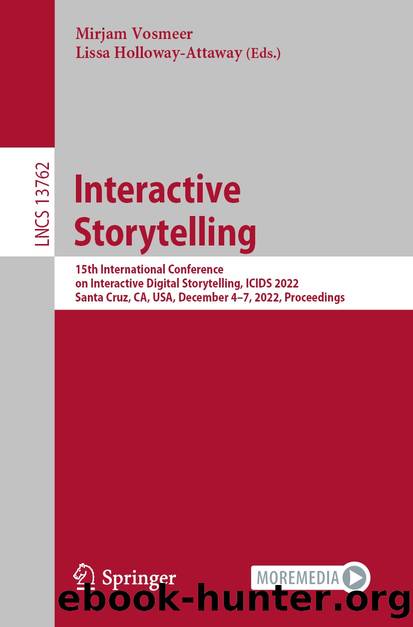Interactive Storytelling by Unknown

Author:Unknown
Language: eng
Format: epub
ISBN: 9783031222986
Publisher: Springer International Publishing
Although not directly related to SSPs, numerous video games are based on ecology or environmental crisis. Examples include: Eco [4], a game in which players collaborate to create a civilization on a virtual planet; The Sims4: Eco Lifestyle [23], where they are encouraged to adopt environmentally friendly behaviors; Fate of the World [6], a turn-based strategy game in which users must manage the resources available to an ever-growing population in the context of global warming; Civilization VI: Gathering Storm [3], which incorporates natural disasters related to climate change, The Climate Game [24], whose goal is to reach ânet zeroâ by 2050 by answering multiple choice questions, and Walden a game [27], which offers to relive the experience of the philosopher Henry David Thoreau when he chose to settle in the woods for more than two years and subsist only on the resources offered by nature. The last one differs from the others in the sense that it is not based on anticipation, since it relates events that took place in the 19th century. However, it is the game that best integrates the narrative dimension, which is at the heart of this article, a fact that is not so surprising since the game is directly inspired by two major works by Thoreau, Walden: or Life in the Woods [25] and his Journal [26]. All the others, with the exception of The Climate Game whose game mechanics follow a question/answer logic, are strategy games, management games or simulation games, genres that certainly include some elements specific to the narrative, but which cannot be assimilated to narrative games. However, the project, which we describe here, which consists in using SSPs to design an interactive narrative would follow an inverted scheme, that is to say a narrative game integrating some management and simulation elements.
To return to the SSPs, the fact that the scientific experts propose from the outset not one but five scenarios, is central to the approach. This set of scenarios is there to signify the presence of different possible futures, and one can thus consider this set as a large multi-linear scenario, which presents several parallel temporal trajectories, in the manner of films such as Groundhog Day, Run Lola Run or Smoking/No Smoking. Multi-linear narratives can be of several types. In the case of the SSP narratives, the five scenarios correspond to five alternative realities, five possible worlds, whose supposed future actualization depends, at least in part, on the actions taken by society. The situation is similar in the films shown as examples above. The creation of an alternative depends on the choices made by certain characters in the story, by branching off from a âmotherâ variant. These choices are rather implicit in the summarized scenarios that are given to us. For example, scenario SSP4 states: âEnvironmental policies focus on local issues around middle and high income areasâ. Faced with such a scenario structure, a transition to interactivity occurs naturally: the choices that make it possible to move from one scenario to
Download
This site does not store any files on its server. We only index and link to content provided by other sites. Please contact the content providers to delete copyright contents if any and email us, we'll remove relevant links or contents immediately.
Never by Ken Follett(3489)
Machine Learning at Scale with H2O by Gregory Keys | David Whiting(3436)
Fairy Tale by Stephen King(2855)
Will by Will Smith(2547)
Fantastic Beasts and Where to Find Them: The Original Screenplay by J. K. Rowling(2389)
The Storyteller by Dave Grohl(2039)
Can't Hurt Me: Master Your Mind and Defy the Odds - Clean Edition by David Goggins(1960)
Friends, Lovers, and the Big Terrible Thing by Matthew Perry(1954)
It Starts With Us (It Ends with Us #2) by Colleen Hoover(1917)
Cloud Cuckoo Land by Anthony Doerr(1880)
The Becoming by Nora Roberts(1860)
New Morning Mercies: A Daily Gospel Devotional by Paul David Tripp(1789)
HBR's 10 Must Reads 2022 by Harvard Business Review(1676)
A Short History of War by Jeremy Black(1646)
Cytonic by Brandon Sanderson(1625)
The Complete Witcher by Andrzej Sapkowski(1613)
Go Tell the Bees That I Am Gone by Diana Gabaldon(1570)
515945210 by Unknown(1499)
Leviathan Falls (The Expanse Book 9) by James S. A. Corey(1458)
